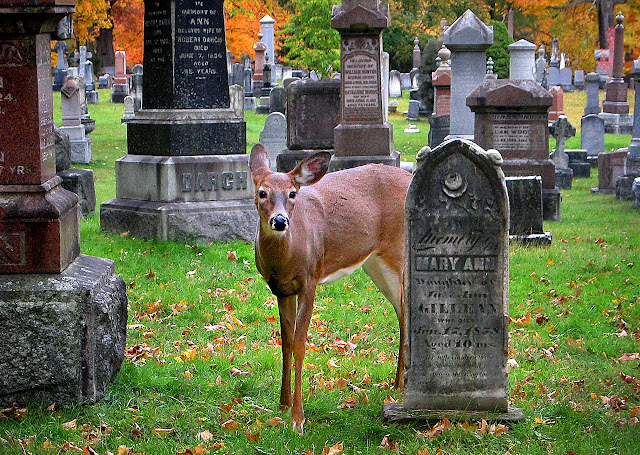Monday, January 6, 2020
Reflective snowplow markers but no snow
In my neighbourhood folk love their lawns but they also need snowplows. Unfortunately, snowplows and lawns don't go together, especially on curved streets. The snowplow drivers find it hard to follow the curves and the result is snowplow blades running over lawns rather than the pavement. Large swaths of sod are peeled and rolled leaving bare soil.
The solution is to place a row of reflective-tipped snowplow markers at the edge of the lawn where the lawn meets the street. My granddaughters, who are longing to go skiing, see the markers as hopeful signs indicating that soon there will be a long-anticipated heavy snowfall.
So far this winter, there has not been enough snow to bring out the snowplows. Some nights it hasn't even been cold enough for the local hill to even make snow. And what snow is made is constantly at risk of being washed off the slopes by a heavy rainfall.
Sunday, January 5, 2020
It's January and Santa is still on display.
Cemetery tombstones can hint at a sad story. My wife found the birth-death dates carved on this stone quite upsetting. In a word: heartbreaking. On the surface, the seasonal decorations seemed to cast a hopeful, optimistic feel. My wife is not so sure. Looking at the decorations, my wife felt the message was ambiguous. She believed painful memories were possibly on raw display. The Santa carries a sign asking those stopping by to leave a message. I wish we had left a message of heartfelt sympathy.
Saturday, January 4, 2020
Abundant geese and urbanization go together
Should a picture of Canada geese overwintering in a park in London, Ontario, appear in blog devoted to urbanization? Yes, it should.
The Canada goose thrives in cities. Safe from most predators, often fed by bird-loving city folk, the large birds form large gaggles, the name for a flock of these birds. And these gaggles can cause urban grief. For instance, in Fredericton New Brunswick the birds interfere with traffic and if irritated will honk at impatient car drivers.
At the very least, the hundreds of geese filling Springbank Park in London make walking in the park difficult, unless one isn't put off by numerous small piles of bird poop. Yuck.
According to Yuval Noah Harari, the author of Sapiens, humans are responsible for driving far more animals into extinction that we usually acknowledge. While a large number of animals are threatened by man, there are some, like the Canada goose, that seem to thrive with thanks to the intervention of man.
Sadly, in most cases neither outcome, extinction or thriving, is desirable.
Friday, January 3, 2020
Gene turns eastern grey squirrels black
Technically, it's an eastern grey squirrel, or so I understand, but its fur is black and not grey. It seems black squirrels have a DNA modification that results in black-furred grey squirrels. Grey or black both squirrels belong to the same species: backyardi pesti.
The little monsters dig up my wife's tulip bulbs long before the plants bloom and eat each and every one they find. That said, I have to admit the fluffy-tailed rodents are cute and cute will takes a wild, urban animal a long way with my three granddaughters.
Without flower bulbs to devour, our backyard pest is supplied with slices of apples, chunks of carrots and handfuls of raw nuts by my three granddaughters. This keeps the squirrels happy. Grandma? Not so much.
Thursday, January 2, 2020
The Mallard: abundant and widely distributed
These male ducks, with their iridescent green heads, are very common in London, Ontario, even in the winter. This comes as no surprise as mallards are said to be the most abundant and widely distributed duck species in North America. Mallards are also found in Europe and Asia.
According to Ducks Unlimited, "With the exception of the muscovy duck, mallards are the predecessors of all domestic ducks; they have been domesticated in Southeast Asia for over 2000 years and in Europe since at least the 12th century.
Wednesday, January 1, 2020
Happy New Year!
I'm not sure if this is my favourite photo of the year or not but it certainly places high. I like it so much it makes me seriously consider moving to the spot pictures in a few years. It looks like a pleasant place to spend some time. I know my granddaughters would enjoy visiting me if I moved into a neighbourhood featuring a small herd of urban deer.
Tuesday, December 31, 2019
Jumbo statue in St. Thomas outside London
The Jumbo statue is located in St. Thomas about twenty-five minutes or so from my London home. The life-sized statue was erected in 1985 to mark the 100th anniversary of Jumbo's death. Possibly the most famous elephant who ever lived, "The King of Elephants" was killed when struck by a railroad locomotive in the southwestern Ontario city.
Earlier this year, the CBC did an excellent take on Jumbo, his life and death. Here is a link to:
Jumbo: The Life Of An Elephant Superstar.
According to the CBC, "More than a century after his death, mystery still swirls around Jumbo. Was he really the tallest elephant in the world? How was he treated? Was his death part of a conspiracy?"
Subscribe to:
Posts (Atom)






